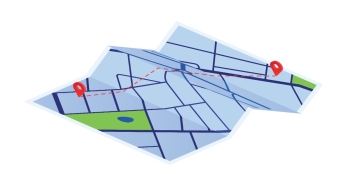
10 Questions to Map Out Your Relationship: Making the decision to go to couple’s therapy can be intimidating. Relationship expert Dr. John Gottman speculates that most couples wait an average of six years of being unhappy in their partnership before getting outside support. Six years! That’s six years of time where unhealthy dynamics and patterns can form and go unaddressed; patterns of built up resentments, communication challenges, and lost time when you are not getting your needs met and are further disconnecting from your partner. While this can be disconcerting, it is nothing to be ashamed of as none of us are given a guidebook on how to navigate our relationships. Couples therapy offers an amazing opportunity to take a look at your relationship to not only identify patterns and dynamics, but to also create a roadmap for change.
By the time most couples start therapy, they have reached a pivotal point in their relationship. Maybe it’s an affair, a disagreement over a significant life decision, or a difference in parenting styles. Maybe it’s a make or break situation where each partner is questioning their ability to be happy in the relationship or whether their partner is capable of change. In essence, the stakes are high and both partners are left feeling extremely vulnerable and emotional.
While it can feel precarious, the decision to try couples therapy should be viewed as a positive step in the right direction. Each person has the opportunity to develop an understanding of their own role in the development of unhelpful patterns, which can be the first step to working on the relationship. The beauty of couples therapy is that you have the support of a trained and unbiased professional to work with you to help you understand how you got yourself into this pickle and to chart the best path forward and navigate difficult conversations along the way. Building awareness of issues and contributing factors paired with the willingness and desire to change can lead to life-changing results.
Given that couples who start therapy are generally at a critical point in their relationship, there is a high likelihood that the whole picture gets lost, as the focus is now on what is not working. Mapping out the entirety of a couple's relationship is a critical first step in therapy because it gives each person the opportunity to deliberately reflect on where they have been, what is working, what is not working, and where they would like to go moving forward. It helps the therapist and the couple gain a shared understanding of their relationship, identify patterns and themes, and gain insight into the evolution of their relationship. While it is important to address the issues and to get back to a good place, it is impossible to do so without taking a complete inventory of the relationship. Doing so can also help remind the couple what they find attractive and special about their partner, why they are together in the first place, and highlight relationship strengths.
Mapping out the relationship means exploring the relationship timeline and your collective history, identifying patterns of behavior and communication, and understanding the beliefs and values that guide each person’s interactions. Mapping is a mechanism of understanding the relationship, and from understanding comes empowerment and more space to make positive changes. It is an important first step for each person to complete individually without input from their partner, as it offers each person a chance to dial into their unique perspective. Doing this exercise lays the foundation for understanding the dynamics at play and sets the stage for the work to come. The process of mapping out the relationship requires the couple to be open and honest about their relationship. Doing this individually also feeds into couples therapy, as it provides the therapist with a holistic view of both individuals and sheds light on the perceived disparities.
Five Benefits of Mapping Out the Relationship:
Identifying patterns and dynamics: Mapping out a relationship involves stepping back to look at the relationship as a whole. Looking at a collection of events and experiences rather than looking at things in isolation allows the therapist and the individuals to identify patterns, themes, and dynamics that are contributing to the current state of the relationship. What are your different roles in the relationship? How do you each communicate? How are your expectations similar? How are they different? Identifying patterns and dynamics allows the therapist to identify the underlying issues and develop effective strategies to improve their relationship moving forward.
Providing context: Mapping out a relationship history provides insight into their current struggles and how their dynamic has evolved. By exploring significant events, milestones, and transitions, the couple gains a deeper understanding of the internal and external dynamics that contribute to a couple's problems. When have you been strong as a couple? When have you been challenged as a couple? What are some events that have defined each period? Taking a look at the relationship timeline can help a couple understand what period, if any, you would specifically like to work back to and where things have broken down overtime.
3. Developing targeted goals: Mapping out a couple's relationship helps set therapy goals by focusing on individual needs and areas of improvement. Each person has the opportunity to reflect on their needs. What is most important to you? Has this changed overtime? Completing the exercise separately helps identify underlying issues, develop comprehensive therapy goals, and provide direction and focus for treatment, which can help the couple to feel more motivated and invested in the process.
4. Promoting insight and growth: Mapping out a couple's relationship promotes growth by helping them gain a deeper understanding of themselves and each other. Examining family dynamics can also be beneficial as it helps uncover limitations and unhelpful communication styles that may be replicated and can lead to new insights and perspectives on the relationship. This facilitates positive change and growth in the relationship.
5. Creating a safe environment: Mapping out a couple's relationship can help to establish rapport between the therapist and the couple. Exploring the history of the relationship in the presence of a therapist can help each person feel validated and understood. This can help to build trust and create a safe space for the couple to explore their issues. Openness and honesty helps build trust between the couple and the therapist, which is critical for the success of the process.
An Exercise: 10 Questions to Help You Map Out Your Relationship
This is a writing exercise. You will want to grab a pen and some paper or your favorite notebook, and set aside some time for yourself to complete this task.
This exercise is designed to be completed independently without the other person's input in order to honor your individual experience in the relationship.
Think about the length of your relationship together. The goal is to really put your perspective of the relationship down on the page. What does it look like for each of you when the relationship is good? What have the dark periods looked like? Here are some prompts to get you thinking....
Think about how you have felt emotionally throughout your relationship. What periods have brought about different feelings, positive and negative? What was characteristic of different periods? (examples: joy, contentment, sadness, anger, ambivalence, isolation, confusion)
What initially attracted you to your partner? What specific qualities made you choose them over others?
What are some strengths in your relationship? Under what circumstances do these strengths come out?
What has your relationship dynamic looked like throughout the years? (Are things equal, is there one person who is more dominant than the other? Has this changed over the course of time?)
What has your focus on the relationship looked like throughout the years? (Has anything shifted your attention on one another and how you spend time together?)
Are there times you have been able to connect deeply / felt your partner went above and beyond for you / felt understood and accepted by your partner?
Are there times you felt really distant from your partner / felt misunderstood or that they were uninterested / felt uncomfortable/unsafe sharing / felt dismissed or unaccepted?
Has your communication changed in the course of your relationship? Do you and your partner communicate differently? How? What periods were you each more open and connected and curious?
What does communication look like during times of conflict? To what extent are you able to respectfully disagree? How often do things escalate? Do you have different expectations of how a conflict should be resolved?
Has your partner helped you grow? In what way? Conversely, has your partner ever restricted your growth?
After completing the exercise, share your thoughts and feelings with your partner. As you review your partner’s responses, try to keep an open mind and be in “receive” mode rather than “respond” mode.
What “respond” mode looks like:
Interrupting your partner, debating with your partner, sharing how you feel, e.g. “That’s not true”, “I can’t believe you feel…”, “It isn’t my fault…”, “It is because you…”
What “receive” mode looks like:
Maintaining eye contact with your partner, engaging in active listening, e.g. “I heard you say…”, “That must feel...”, “I understand you…”
5 Tips to Help You Stay in “Receive” Mode:
Acknowledge that you will have the same opportunity to share your perspective and the reality that you may have different perspectives or disagree on some points
Recognize that while some things may be difficult to hear, bringing everything out into the open will help you fully understand your partner and attend to their needs
Notice the energy in your body and feelings as you listen (but don’t respond)
Use a notebook to take notes on things that stood out to you and/or surprised you
Ask your partner to “share more” if there is something you want to further understand
The information can provide a guideline for the couple to be on the same page and ensure each person’s unique needs are given equal attention. This understanding sets the stage for connection and being able to address the specific needs of each person.
If you are interested feeling stuck and would benefit from getting support from a therapist, at the Center for Growth, located in Philadelphia, Pennsylvania, Ocean City, New Jersey, Mechanicsville, Virginia, and Santa Fe, New Mexico, trained couple’s therapists are available to help you navigate mapping out the relationship and doing the important work of navigating and defining each person’s unique needs after the exercise to create a comprehensive plan to help you move forward.























